3D Printing Geopolymer Filters for Water Treatment Systems
Researchers from Italy and Finland are focused on improving ways to deliver clean drinking water, detailing their study in the recently published ‘Ag- or Cu-modified geopolymer filters for water treatment manufactured by 3D printing, direct foaming, or granulation.’
While ceramics have shown potential in water treatment due to both chemical and physical stability, affordability has been an ongoing stumbling point—mainly because polymers are cheaper to use. Geopolymers, similar to ceramic, are a low-calcium, amorphous material composed of aluminosilicate. They offer a pore diameter of 2–50 nm, as well as good mechanical properties, and may possibly offer the best of both worlds in comparison to ceramics and other polymers due to lower cost, stability, and longevity.
Previous proof-of-concept studies have shown that geopolymers are suitable as antimicrobials, as well as metakaolin and fly ash materials. Cu2+-exchanged metakaolin geopolymers have also been found in previous research to be effective in preventing the growth of oyster mushroom hyphae and resulting bacteria.
“In (photo)catalytic water treatment applications, the successful impregnation of catalytically active metals/semiconductors (such as TiO2, Cu2O, Cd) into the geopolymer structure is also crucial,” stated the researchers.
With high-open porosity as a critical concern, the researchers also theorized that 3D printing would offer more control over the following:
- Pore size
- Pore-size distribution
- Pore shape
- Pore interconnectivity
“Moreover, components with stochastic porosity tend to have a lower strength in comparison to components possessing a more homogeneous porous microstructure, such as the ones produced by AM—important properties, such as permeability and tortuosity, can be designed and more easily optimized in the latter,” explained the authors.
For this study, a metakaolin-based geopolymer was chosen for fabrication of metal-modified water treatment filters with the goal of creating properties inspired by ceramic pot filters with the following: open porosity, compressive strength, and water permeability of not less than approximately 30%, 1 MPa, and 0.001 cm/s, respectively.
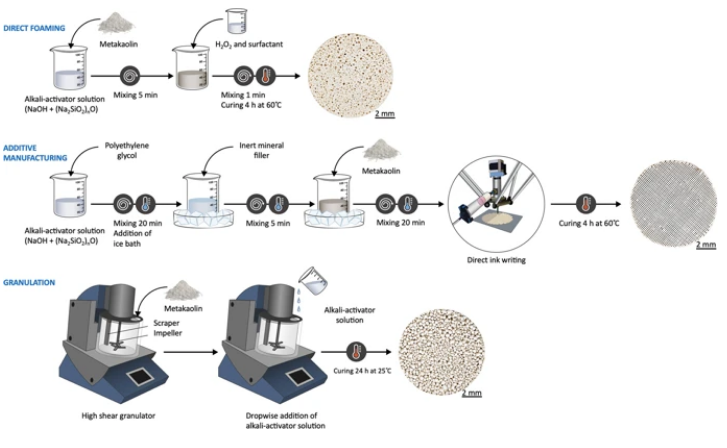
Manufacturing methods and appearance of geopolymer samples. Note that in direct foaming, the solid surfactants were dissolved to alkali-activator solution (i.e., not added together with H2O2).
Samples were created using direct-ink writing (DIW), direct foaming, and granulation-geopolymerization. Morphology and characteristics of all the samples were different, and because the researchers were concerned about changes ‘over time,’ they performed characterization one month later.
Regarding the geopolymers produced via DIW, the researchers noted technical challenges, with the paste and properties changing over time. Although the paste was suitable enough in terms of rheological properties, there were issues with layers sagging and merging:
“However, as the condensation reactions continuously progressed with time in the ink, viscosity and yield strength increased and the upper layers of the scaffolds were printed without sagging,” stated the researchers. “The difference between the lower and upper layers is remarkable, as it takes quite some time to deposit each layer (∼10 min). In fact, sagging and merging would at least partially decrease the dimension of the openings in the first layers of filaments, reducing the filters’ porosity, surface area, and permeability.”

(A) Rheological behavior of the paste showing shear-thinning behavior, and (B) dynamic mechanical analysis at 1 Hz showing the yield point at 160 Pa.
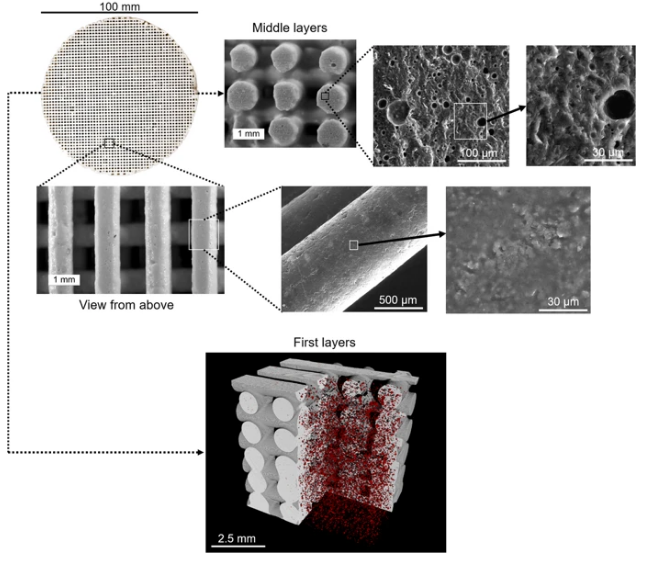
3D-printed geopolymer filter imaged with a DSLR camera, optical microscopy, scanning electron microscopy (SEM), and X-ray microtomography. In the microtomography image, red dots represent the internal (closed) pores, which are also visible in the cross-sections imaged with SEM.
3D printing resulted in scaffolds with higher compressive strength, lower porosity, and greater thickness.
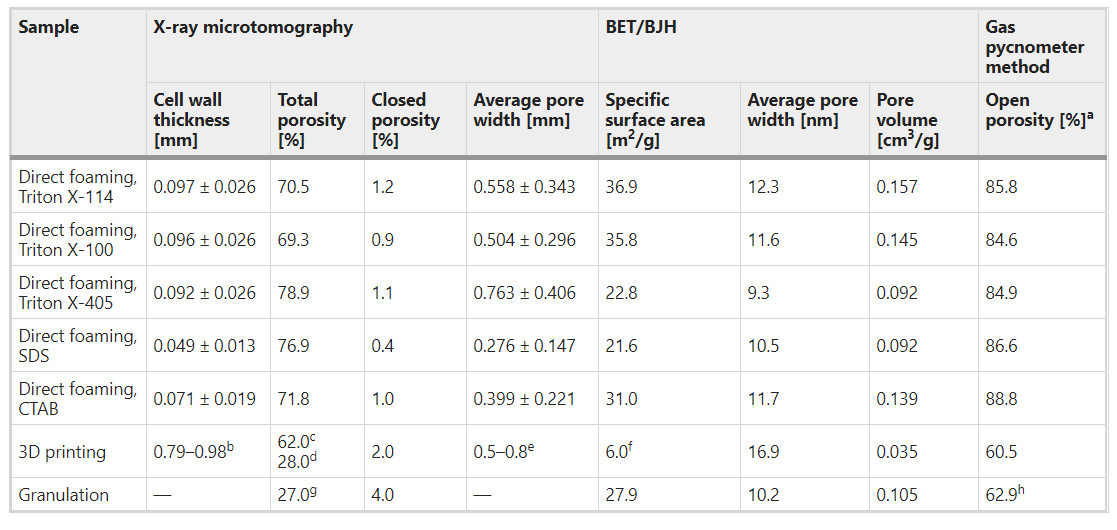
SDS = sodium dodecyl sulfate; CTAB = cetyltrimethylammonium bromide; a = open porosity ≈ total porosity; b = filament thickness; c = porosity in upper layers; d = porosity in the first layers; e = diameter of openings between filaments; f = specific surface area was measured after washing with hot, deionized water (before washing, specific surface area was 2.1 m2/g); g = porosity within granules; h = porosity of granule bed, including voids between granules.
“In terms of the mechanical strength, 3D-printed filters could be most suitable for applications with a high-water flow rate, causing higher shear forces,” stated the researchers.

(A) Compressive strength (at 7 d age) of filter materials prepared with direct foaming, granulation, or 3D printing. (B,C) show optimization of water content and surfactant content with Triton X-100. Error bars represent ± standard error. SDS = sodium dodecyl sulfate and CTAB = cetyltrimethylammonium bromide.
Headwater permeability was lower in comparison to the other samples for the 3D printed filter, most likely due to the sagging, the plasticizing agent, and issues with lack of porosity in the filament.
“This result is, however, somewhat surprising, since the designed filters possessed continuous and unobstructed open channels,” stated the authors. “This parameter could certainly be increased by modifying the scaffold design and further improving the ink rheology and composition. Nevertheless, the obtained value was still comparable to those of conventional ceramic pot filters.”
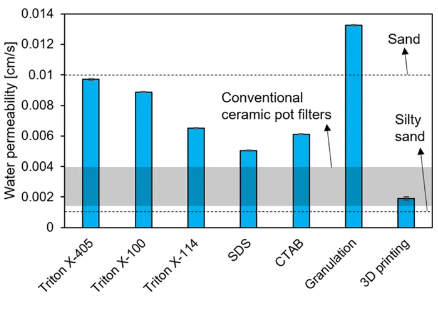
Water permeability coefficients of the filter samples. Values for sand, silty sand, and conventional ceramic pot filters are shown as reference.
Direct foaming was affected substantially by viscosity and setting time, leaving the researchers to state that paste viscosity could interfere with the foaming effect. The thickness of cell walls increased as porosity levels decreased (except for the Triton X-405 samples), and direct-foamed surface areas were ‘in good agreement’ with previous research.
“It has been noted that conventional ceramic pot filters are prone to clogging by suspended matter, and thus high-water flows would be beneficial,” said the authors. “However, the mechanical strength of the direct-foamed materials could limit their use in high-flow (i.e., high shear force) applications.”

Morphological characterization of direct-foamed samples (with an equimolar concentration of surfactants) in order of ascending cell wall thickness (shown with the color bar): (A) sodium dodecyl sulfate (SDS); (B) cetyltrimethylammonium bromide (CTAB); (C) Triton X-405; (D) Triton X-100; (E) Triton X-114.
While granulation-geopolymerization is significantly different from both 3D printing and direct foaming, the researchers considered the possibility that it is the simplest production method for upscaling, with the granule bed easy to replace as needed.
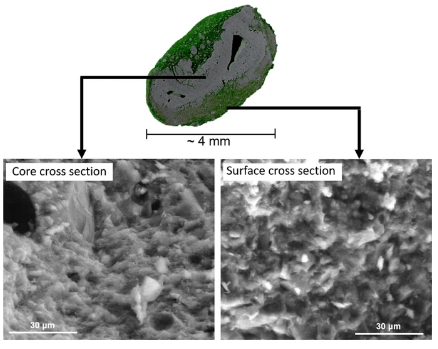
Morphological characterization of a geopolymer granule with X-ray microtomography and SEM. The green part represents the porous surface layer and the gray part represents the dense core.
“The lowest level of Ag leaching was observed with the 3D-printed geopolymer scaffolds modified with AgNPs, dipping into a colloidal Ag solution, or the addition of AgNO3 to a fresh paste, and with direct-foamed geopolymer modified with AgNPs,” concluded the researchers. “With these manufacturing methods, it was possible to meet drinking water guidelines of a maximum 0.1 mg/L Ag. For Cu, the lowest level of leaching (Cu < 2 mg/L) was reached with geopolymer granules with the addition of Cu(NO3)2. Ion exchange proved to produce unstable materials that leached 100% of added metals.
“The next steps in this research will be to test the most promising filters in water treatment, namely in disinfection and advanced oxidation processes (AOPs).”
3D printing has accentuated many different projects regarding water, around the globe, from the creation of microdevices for clean water to fog harps for harvesting water, and a variety of water filters. What do you think of this news? Let us know your thoughts! Join the discussion of this and other 3D printing topics at 3DPrintBoard.com.
Subscribe to Our Email Newsletter
Stay up-to-date on all the latest news from the 3D printing industry and receive information and offers from third party vendors.
Print Services
You May Also Like
3D Printing Financials: Rocket Lab’s Record-Breaking Year and Over 20 Launches Coming in 2025
Rocket Lab (Nasdaq: RKLB) closed 2024 with its best year yet. The company launched more rockets, signed more contracts, and expanded deeper into spacecraft and satellite production than ever before....
3D Printing Financials: Prodways Ends 2024 with a Profit
After a tough couple of years, Prodways (EPA: PWG) is starting to bounce back. The French 3D printing company finally made a profit in 2024, improved its operating performance, and...
3D Printed Rocket Motor Specialist Ursa Major Lands $15M Satellite Propulsion Contract
Ursa Major, the Colorado-based leader in deploying additive manufacturing (AM) for propulsion solutions, has received a contract from an unnamed customer for geostationary earth orbit (GEO) propulsion systems. The multi-year...
3D Printing Financials: Stratasys Ends 2024 with Cost Cuts and Growth Plans
Stratasys (Nasdaq: SSYS) has wrapped up 2024 with stronger margins but a full-year net loss. The polymer 3D printing leader navigated a year of economic headwinds, restructuring efforts, and shifting...




























